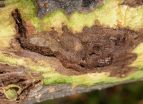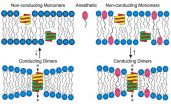(Press-News.org) HOUSTON, Nov. 13, 2014 - A team of University of Houston (UH) chemistry researchers have developed a molecule that assembles spontaneously into a lightweight structure with microscopic pores capable of binding large quantities of several potent greenhouse gases.
"Greenhouse gases, such a carbon dioxide, have received much attention lately because of their potential to dramatically affect Earth's climate, primarily the temperature of the planet," said Ognjen Miljanić, a UH associate professor of chemistry and leader of the team.
While carbon dioxide presents the biggest problem, Miljanić notes that several other compounds are hundreds or thousands of times more potent in their greenhouse effect per unit of mass. These compounds include Freons, used as common refrigerants, and fluorocarbons, highly stable organic compounds in which one or more hydrogen atoms have been replaced with fluorine.
"We developed a molecule that self-assembles into a structure that can capture these greenhouse vapors to the tune of 75 percent by weight," Miljanić said. "This molecule could be used to capture Freons from disposed refrigeration systems, for example, or to concentrate them prior to analysis of their content."
In their recent paper in Nature Communications, Miljanić and his colleagues report that a small molecule based on an extensively fluorinated backbone will form a structure with extremely small pores about 1.6 nanometers in diameter. Members of the team included Miljanić and professors Allan Jacobson and Olafs Daugulis, all from UH's Department of Chemistry in the College of Natural Sciences and Mathematics.
"These tiny pores are lined with fluorine atoms, giving them a high affinity for other molecules containing fluorine - such as fluorocarbons and Freons," Miljanić said.
Porous materials with similar pore sizes have been developed in previous studies, but those materials were often heavy, because of the presence of metals, as well as sensitive to water and difficult to process and recycle.
"The advantages of the current material is that it is stable to water and composed from individual molecules held together only by weak interactions," Miljanić said. "This latter feature makes this material lightweight, because there are no metal connectors."
The weak interactions between the molecules can be broken when needed, so the molecule can be recycled or deposited on a surface. The molecule is stable to 280 degrees Celsius.
In this international collaboration, UH researchers worked with Yu-Sheng Chen from the University of Chicago and Yu-Chun Chuang from the Taiwan National Synchrotron Radiation Research Center. A provisional patent based on this work has been filed.
INFORMATION:
About the University of Houston
The University of Houston is a Carnegie-designated Tier One public research university recognized by The Princeton Review as one of the nation's best colleges for undergraduate education. UH serves the globally competitive Houston and Gulf Coast Region by providing world-class faculty, experiential learning and strategic industry partnerships. Located in the nation's fourth-largest city, UH serves more than 40,900 students in the most ethnically and culturally diverse region in the country. For more information about UH, visit the university's newsroom at http://www.uh.edu/news-events/.
About the College of Natural Sciences and Mathematics
The UH College of Natural Sciences and Mathematics, with 193 ranked faculty and nearly 6,000 students, offers bachelor's, master's and doctoral degrees in the natural sciences, computational sciences and mathematics. Faculty members in the departments of biology and biochemistry, chemistry, computer science, earth and atmospheric sciences, mathematics and physics conduct internationally recognized research in collaboration with industry, Texas Medical Center institutions, NASA and others worldwide.
To receive UH science news via email, sign up for UH-SciNews at http://www.uh.edu/news-events/mailing-lists/sciencelistserv/index.php.
For additional news alerts about UH, follow us on Facebook at http://www.facebook.com/UHNewsEvents and Twitter at http://twitter.com/UH_News.
(SACRAMENTO, Calif.) -- Researchers at UC Davis and other institutions have found that diets rich in whole walnuts or walnut oil slowed prostate cancer growth in mice. In addition, both walnuts and walnut oil reduced cholesterol and increased insulin sensitivity. The walnut diet also reduced levels of the hormone IGF-1, which had been previously implicated in both prostate and breast cancer. The study was published online in the Journal of Medicinal Food.
"For years, the United States government has been on a crusade against fat, and I think it's been to our detriment," ...
WEST LAFAYETTE, Ind. - Researches have uncovered "smoking-gun" evidence to confirm the workings of an emerging class of materials that could make possible "spintronic" devices and practical quantum computers far more powerful than today's technologies.
The materials are called "topological insulators." Unlike ordinary materials that are either insulators or conductors, topological insulators are in some sense both at the same time - they are insulators inside but always conduct electricity via the surface. Specifically, the researchers have reported the clearest demonstration ...
Boulder, Colo., USA - Seismic hazards in the Puget Lowland of northwestern Washington include deep earthquakes associated with the Cascadia subduction zone and shallow earthquakes associated with crustal faults across the region. Research presented in Geosphere this month establishes not only that one of the more prominent crustal faults, the Darrington-Devils Mountain fault zone, displays evidence of strong earthquakes in the past, but that it will likely be a source of strong earthquakes in the future.
Paleoseismic investigations on the Darrington-Devils Mountain fault ...
New Rochelle, NY, November 13, 2014--The two U.S. FDA approved oligonucleotide-based drugs on the market both have a modified chemical backbone made of phosphorothioates. The therapeutic advantages of the phosphorothioate group and the new types of gene expression-regulation oligonucleotide drugs that it is enabling are detailed in a Review article in Nucleic Acid Therapeutics, a peer-reviewed journal from Mary Ann Liebert, Inc. publishers. The article is available free on the Nucleic Acid Therapeutics website until December 13, 2014.
In the article "Phosphorothioates, ...
WEST LAFAYETTE, Ind. - Researchers from Purdue and Colorado State universities have discovered that the fungus responsible for thousand cankers disease, a lethal affliction of walnut trees and related species, has a rich genetic diversity that may make the disease more difficult to control.
Adjunct assistant professor of forestry Keith Woeste and fellow researchers analyzed the genes of 209 samples of Geosmithia morbida from 17 regions of the U.S. to determine the genetic diversity of the fungus, its possible origin and how it spread throughout the West and to parts of ...
Anesthesia, long considered a blessing to patients and surgeons, has been a mystery for much of its 160-plus-year history in the operating room.
No one could figure out how these drugs interact with the brain to block pain and induce a coma-like, memory-free state. The debate has divided the anesthesia research community into two camps: one that believes anesthetics primarily act on the cell membrane (the lipid bilayer) of nerve cells, perhaps altering it to the point that embedded proteins cannot function normally. The other says the membrane proteins themselves are ...
For the first time in history, a spacecraft has landed on a comet. The momentous event represents the culmination of 35 years of research on comets by Prof. Akiva Bar-Nun of Tel Aviv University's Department of Geosciences and other scientists working for the European Space Agency.
At 08:35 GMT on Wednesday, November 12, the European Space Agency's Rosetta satellite released its lander Philae towards Comet 67P/Churyumov-Gerasimenko, a large mass of ice and dust some 316 million miles from Earth. The descent took approximately seven hours, with a signal confirming touchdown ...
West Lafayette, Ind. (November 13, 2014): Scientists with the U.S. Forest Service and Colorado State University examined a fungus native to North America, the native beetle that carries it, and their host tree and found something surprising: Geosmithia morbida and the walnut twig beetle co-evolved and, while the beetle/fungus complex was once the equivalent of a hang nail for a black walnut tree, it has become lethal.
Research published today in the journal PLOS ONE by U.S. Forest Service scientist Keith Woeste, Colorado State University scientists Marcelo M. Zerillo ...
This news release is available in French. Montreal November 13, 2014 - Is it possible to change the amount of information the brain can store? Maybe, according to a new international study led by the Research Institute of the McGill University Health Centre (RI-MUHC). Their research has identified a molecule that puts a brake on brain processing and when removed, brain function and memory recall is improved. Published in the latest issue of Cell Reports, the study has implications for neurodevelopmental and neurodegenerative diseases, such as autism spectral disorders ...
TORONTO, ON (13 November 2014) Astronomers from the University of Toronto and the University of Arizona have provided the first direct evidence that an intergalactic "wind" is stripping galaxies of star-forming gas as they fall into clusters of galaxies. The observations help explain why galaxies found in clusters are known to have relatively little gas and less star formation when compared to non-cluster or "field" galaxies.
Astronomers have theorized that as a field galaxy falls into a cluster of galaxies, it encounters the cloud of hot gas at the centre of the cluster. ...



